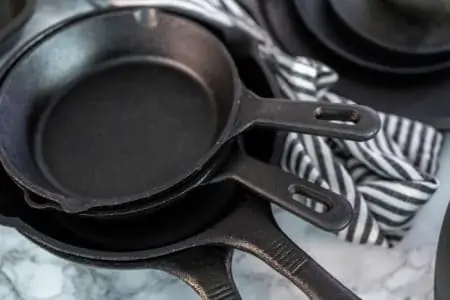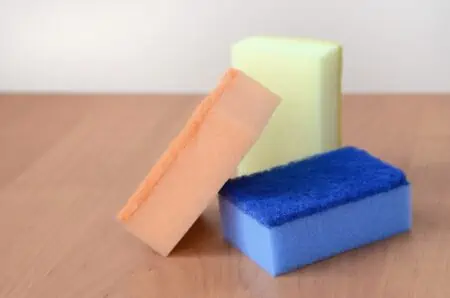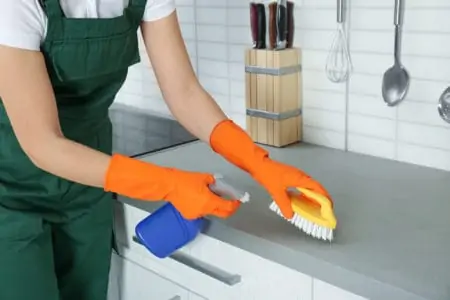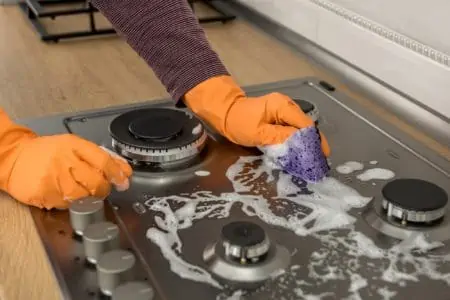Cleaning your cast iron pan wrong can ruin it — and cast iron is not cheap. With that being every cook’s worst nightmare, it’s important to know how to clean cast iron properly.
We’ll run you through the step-by-step instructions for cleaning, seasoning, and storing cast iron cookware. Plus, we’ve got the answers to some of the most frequently asked questions.
Key Takeaways
- Let the cast iron cool down completely before cleaning with hot water and a stiff brush specifically made for cast iron.
- To remove stuck-on food, create a paste of water and kosher salt and scrub the areas well. Rinse and dry thoroughly immediately to avoid rust.
- Season your cast iron pan by applying vegetable shortening and baking it in the oven at 350°F for 1-2 hours. This creates a protective layer for better cooking and easier cleanup.
- Store cast iron pans on the stovetop or in a dry cupboard with paper towels or dish towels between cookware to avoid scratches and rust.
How to Clean Cast Iron
When you’re done cooking with your cast iron pan, don’t clean it right away. Instead, follow these instructions.
- Let it cool: Don’t blast your cast iron cookware with water immediately after cooking. The sudden temperature changes can cause warping (1). Instead, let it cool down completely before moving on.
- Hot water: Once the pan has cooled, run it under some hot water to loosen up stuck-on food.
- Scrub: You should now scrub clean the cast iron cookware with a stiff brush specifically made for cast iron. You don’t need soap or anything abrasive to clean. These substances can take away the seasoning of the pan. It might seem a little weird to clean a pan without soap but it’s okay.
- Removing stuck-on food: If the stiff brush and hot water haven’t removed stuck-on food, there’s another trick you can try. Create a paste with water and kosher salt and scrub the areas well. Alternatively, you can heat the cast iron pan on the stove using a low temperature. The heat should loosen the food up, and you should be able to scrub them off with your stiff brush. Never soak a cast iron pan in hot water to remove stubborn bits of food; this can lead to rusting.
- Dry: Dry the cast iron cookware immediately with a dish towel. If you don’t, it could easily rust.
Extra Tips
Never put cast iron in the dishwasher. This will ruin it for sure . Another thing — if you do use soap or an abrasive sponge, you will need to re-season your pan before using it again.
How to Season Cast Iron
It’s likely that your cast iron pan came from the manufacturer unseasoned, but that doesn’t mean it’s ready to go like that. You should season it before you use it. This will create a nice coating over the pan for better cooking, a longer lifespan of the span, and easier cleanup. It won’t create a completely non-stick pan, but it will come pretty close. Here’s how to season cast iron:
- Clean: Make sure the cookware is clean before starting by following the above steps. Even if it’s just arrived, you should still give it a quick clean.
- Dry: Before seasoning, make sure the cast iron is bone dry.
- Heat your oven: The oven is where you’ll season your pan, so heat up your oven to 350°F.
- Apply shortening: While the oven is heating, apply a layer of vegetable shortening all over the cast iron pan. Yep, this even includes the handle and exterior!
- Bake: Place aluminum foil on a baking tray. Put the cast iron cookware face down onto the tray and bake for 1-2 hours. The heat from this will harden the shortening creating a protective seasoning layer.
- Turn oven off: After 1-2 hours, turn off the oven but don’t remove the pan. Let it cool slowly in the oven.
- Remove: Remove and you’re ready to use your pan!
Check This Out
When your cast iron cookware arrives, always check the specific manufacturer’s advice for seasoning it. It may not match up with our advice. You always want to follow the manufacturer’s advice in case the cast iron has added materials that need to be specially treated.
How to Store Cast Iron
With such luxurious and expensive cookware, you don’t want to just wedge it in a cupboard and hope for the best.
The best way to store cast iron is to keep it on the stovetop. Here, it’s away from moisture, dampness, and the risk of being scratched by other cookware in the cupboard.
If you don’t want to keep it on the stovetop, you can store it in your oven. But remember to take it out before turning your oven on.
If you want to store it in a cupboard or cabinet, always make sure it’s dry in there. Ensure that the other cookware, including the cast iron, is also dry otherwise, the cast iron can easily rust. You should also put paper towels or dish towels between the cookware to avoid scratches.
FAQs About Cast Iron
Cooking With Cast Iron
Cast iron is a durable, long-lasting and versatile cookware type. To clean it, all you need is a stiff cast iron brush and hot water. No soap. No sponges. It’s pretty easy to clean, but it does take a bit of getting used to.
The most important thing you can do for your cast iron cookware is to season it well and regularly. This will prevent food from sticking and give you the best possible cooking experience.

















